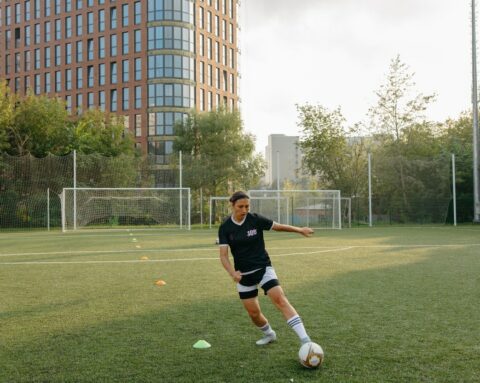Patellofemoral pain syndrome is one of the most common causes of knee pain in both young and older people and is particularly prevalent in very active individuals. Patellofemoral pain syndrome is the technical term for pain felt in the kneecap. When you are active your patella is intended to glide up and down through the femoral groove. When your knee bends you will find that the pressure between the groove and your knee will increase. This pressure may be further increased if the patella mis tracks and travels more to one side which causes it to rub against the femur.
Causes of Patellofemoral Pain Syndrome
If you are someone who partakes in sports such as netball, volleyball, football, basketball, tennis, running or other similar sports that involve running, jumping and landing you may be a part of the 25% of people who have felt aching kneecaps at some point in their lives. However, patellofemoral pain syndrome is also commonly caused by people who have poor biomechanical control or abnormal muscle imbalance.
The causes of muscular imbalance greatly vary. The patella attaches to your quadriceps muscles and an imbalance can occur when your quadriceps pull your patella outwards which can cause your patella to track laterally in the groove. This can be particularly common after surgery or if there is swelling. Another important factor in muscle imbalance can be pinpointed in hip control. Your hip muscle has a large influence over your thighs and buttock muscles which allows your knee to move properly within the groove. Your myotherapist will work closely with you during your rehabilitation program to ensure you have correct hip and buttock muscle control. Finally, patellofemoral pain syndrome can often be seen in people going through adolescence as their bones may in some cases grow faster than the ligaments, muscles and tendons surrounding them. This, in turn, puts undue stress on the joints.
The Symptoms of Patellofemoral Pain Syndrome
The symptoms of patellofemoral pain tend to occur gradually and are usually noticed during jarring or weight-bearing activities that can involve bending your knee. When your pain progresses, you will feel it much more intensely during actions that involve running, hopping, kneeling, squatting or using stairs. It is also possible to experience the pain while in a rested state if the condition has progressed far enough. This is particularly common when you have been seated in the same position for a long period of time.
Treatment
Your patellofemoral pain syndrome treatment in the short term will ensure you reduce the amount of inflammation and pain that you are experiencing before aiming to correct your condition and mechanics in the long term. It is important to have your myotherapist monitor your progress as you develop through each stage as moving to the next level too soon can cause reinjury.
In the initial stages of recovery, it is important to get as much rest as possible and to follow the basic protocols of icing and protecting the injury. Ice is always one of the best ways to reduce your pain and swelling when you notice your affected area is warm. Apply the ice for 20-30 minutes every 2-4 hours during this stage of recovery. Your physio may provide some sort of support to your knee to help relieve initial pain and to begin realigning your joints.
The next step of recovery is to ensure that your knee can move back through its full range of motion. To do this your myotherapist will instruct you on your range of motion and provide you with the necessary techniques. Your muscles will be tight after the injury has occurred which can provide undue stress on your kneecap. Stretching all the major muscles around the area such as your hamstring, calf and thigh is crucial to restoring your muscles to their full length.
We mustn’t allow a recurrence of the injury. One of the best ways to ensure this is to strengthen your knee by normalising the balance of your quadriceps muscles, foot, hip and movement patterns. Patellofemoral pain syndrome can often occur from poor biomechanics so if all of these muscles are not normalised there is an extremely high chance of reoccurrence. This may involve the use of an orthotic for your feet or something more complex such as the adjusted of your running gait or jumping technique. Finally, it is extremely important to restore the power to your muscles and joints. This will involve a careful evaluation of your needs in returning to day to day life and activities of choice by your myotherapist.
Be A Part of The 90%
Thankfully myotherapy & remedial massage are some of the best short- and long-term solutions for pain in your kneecaps. Seeing a Myotherapist or Remedial Massage Therapist could make you a part of the 90% of patellofemoral syndrome affected people that are pain-free within six weeks of treatment guided by a specialist. Book your session with Studio Musculoskeletal today!






